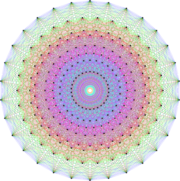Representations of classical Lie groups
 From HandWiki - Reading time: 12 min
From HandWiki - Reading time: 12 min
| Group theory → Lie groups Lie groups |
|---|
 |
In mathematics, the finite-dimensional representations of the complex classical Lie groups
However, since the complex classical Lie groups are linear groups, their representations are tensor representations. Each irreducible representation is labelled by a Young diagram, which encodes its structure and properties.
General linear group, special linear group and unitary group
Weyl's construction of tensor representations
Let
The dimensions of these irreducible representations are[1]
where
- The first formula for the dimension is a special case of a formula that gives the characters of representations in terms of Schur polynomials,[1]
- The second formula for the dimension is sometimes called Stanley's hook content formula.[2]
Examples of tensor representations:
| Tensor representation of |
Dimension | Young diagram |
|---|---|---|
| Trivial representation | ||
| Determinant representation | ||
| Defining representation |
||
| Symmetric representation |
||
| Antisymmetric representation |
General irreducible representations
Not all irreducible representations of
- For
- The dimension of
Case of the special linear group
Two representations
Case of the unitary group
The unitary group is the maximal compact subgroup of
Tensor products
Tensor products of finite-dimensional representations of
where
where the natural integers
Below are a few examples of such tensor products:
| Tensor product | ||
|---|---|---|
Orthogonal group and special orthogonal group
In addition to the Lie group representations described here, the orthogonal group
Construction of representations
Since
Irreducible representations of
Case of the special orthogonal group
The antisymmetric tensor
- For
- For
For example, the irreducible representations of
Dimensions
The dimensions of irreducible representations of
There is also an expression as a factorized polynomial in
where
Tensor products
In the stable range
Branching rules from the general linear group
Since the orthogonal group is a subgroup of the general linear group, representations of
where
Similar branching rules can be written for the symplectic group.[11]
Symplectic group
Representations
The finite-dimensional irreducible representations of the symplectic group
There is also an expression as a factorized polynomial in
Tensor products
Just like in the case of the orthogonal group, tensor product multiplicities are given by Newell-Littlewood numbers in the stable range, and modifications thereof beyond the stable range.
External links
- Lie online service, an online interface to the Lie software.
References
- ↑ 1.0 1.1 1.2 1.3 1.4 1.5 , Wikidata Q55865630
- ↑ Hawkes, Graham (2013-10-19). "An Elementary Proof of the Hook Content Formula". arXiv:1310.5919v2 [math.CO].
- ↑ Binder, D. - Rychkov, S. (2020). "Deligne Categories in Lattice Models and Quantum Field Theory, or Making Sense of O(N) Symmetry with Non-integer N". Journal of High Energy Physics 2020 (4): 117. doi:10.1007/JHEP04(2020)117. Bibcode: 2020JHEP...04..117B.
- ↑ 4.0 4.1 4.2 4.3 , Wikidata Q104601301
- ↑ Cvitanović, Predrag (2008). Group theory: Birdtracks, Lie's, and exceptional groups. https://birdtracks.eu/.
- ↑ Koike, Kazuhiko (1989). "On the decomposition of tensor products of the representations of the classical groups: by means of the universal characters". Advances in Mathematics 74: 57–86. doi:10.1016/0001-8708(89)90004-2.
- ↑ 7.0 7.1 7.2 7.3 Hamermesh, Morton (1989). Group theory and its application to physical problems. New York: Dover Publications. ISBN 0-486-66181-4. OCLC 20218471.
- ↑ 8.0 8.1 Gao, Shiliang; Orelowitz, Gidon; Yong, Alexander (2021). "Newell-Littlewood numbers". Transactions of the American Mathematical Society 374 (9): 6331–6366. doi:10.1090/tran/8375.
- ↑ Steven Sam (2010-01-18). "Littlewood-Richardson coefficients for classical groups". https://concretenonsense.wordpress.com/2010/01/18/littlewood-richardson-coefficients-for-classical-groups/.
- ↑ , Wikidata Q56443390
- ↑ 11.0 11.1 Howe, Roger; Tan, Eng-Chye; Willenbring, Jeb F. (2005). "Stable branching rules for classical symmetric pairs". Transactions of the American Mathematical Society 357 (4): 1601–1626. doi:10.1090/S0002-9947-04-03722-5.
 |
18 views | Status: cached on August 18 2024 16:47:17
↧ Download this article as ZWI file
 KSF
KSF